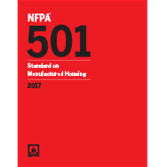Click here to purchase
Assess the appropriateness and execution of a fire risk assessment for a given fire safety problem with the 2013 NFPA 551.
The application of fire risk assessment methods in developing fire and life safety solutions continues to increase. NFPA 551: Guide for the Evaluation of Fire Risk Assessments identifies various types of fire risk assessment methods and describes the properties these methods should possess. While the primary audience is anticipated to be authorities having jurisdiction, the Guide, will also be useful for others who review fire risk assessments, such as insurance company representatives and building owners.
NFPA 551 helps users:
- Apply risk informed decision-making for fire safety
- Select fire scenarios, identify representative challenging scenarios, and group such scenarios into clusters for the purposes of conducting more effective consequence analysis
- Develop appropriate documentation to accompany a fire risk assessment
- Evaluate capabilities of those conducting a fire risk assessment
Comprehensive coverage includes:
- Guidance on how to address uncertainty when conducting a fire risk assessment
- Factors to consider when conducting or reviewing a fire risk assessment
- Guidance on how to address the changing effectiveness of fire protection equipment, features, programs, and procedures
- Discussion on the role of qualitative, semi-quantitative likelihood, semi-quantitative consequence, and quantitative methods in a fire risk assessment
- Discussion on cost-benefit analysis
- Details about proper documentation and elements of a fire risk assessment
- Guidance on applying risk informed decision making for various fire safety goals including the preservation of cultural resources
NFPA 551 also covers the purpose and importance of an operations and maintenance manual in conducting a fire risk assessment, and the importance of using checklists that address both likelihood and consequence.
Product Details
- Published:
- 12/17/2012
- ISBN(s):
- 9781455905966
- Number of Pages:
- 35

